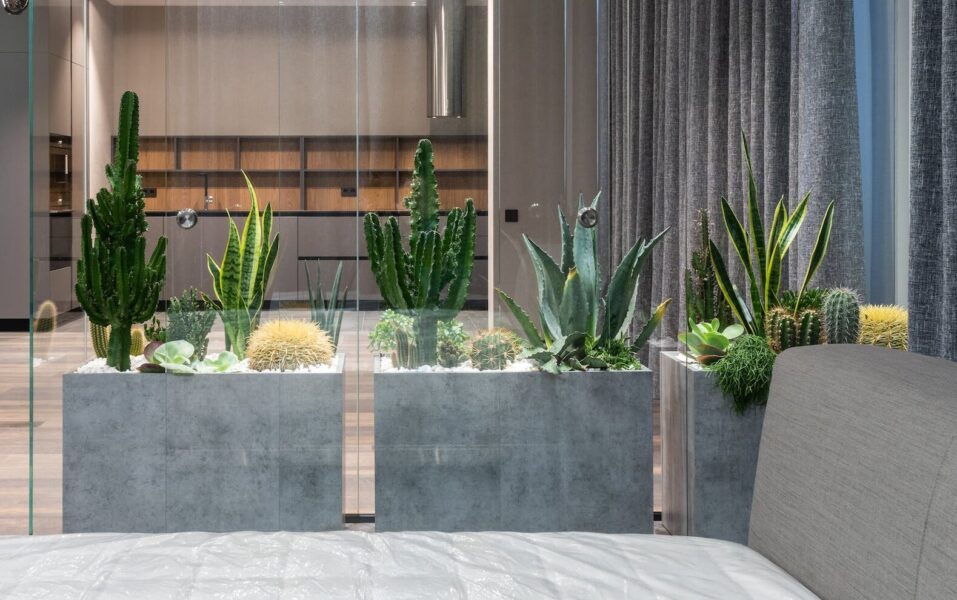Color, Meet Green: Diving into Monochromatic Design
Imagine a world where a single color reigns, wrapping a room in an aura of sleek elegance. Welcome to the realm of monochromatic design! Here, one color gets the spotlight, but it’s not a solo act – the beauty of indoor plants takes the stage too. We have written a series of articles discussing how the color wheel plays a key role in selecting colors as well as other important schemes including analogous color schemes and complementary color schemes. Today, we focus on monochromatic design with plants, a favorite among design buffs, shines in its simplicity and sophistication. Exploring one color and its many shades opens up a treasure trove of design potential.
Monochrome and Green: A Match Made in Design Heaven
The monochromatic design uses a single color and its shades to create a harmonious space. It’s a simple yet visually striking approach that promotes calmness and unity. Adding plants to monochromatic spaces brings numerous benefits. Not only do they improve air quality and reduce stress, but they also enhance the design itself.
Plants inject a delightful splash of color into monochromatic rooms. Picture a serene blue-themed space complemented by lush green foliage or a warm-toned room accentuated by vibrant flowers. By introducing plants, you break the monotony while still maintaining the overall unity.
Texture is another exciting aspect that plants bring to the table. From the smooth leaves of a snake plant to the intricate patterns of a fern, plants add visual and tactile diversity, enriching the simplicity of a monochromatic scheme.
Plants also provide depth and dimension. Strategically placing taller plants in corners or against walls adds verticality, making the room feel more spacious. The layering effect of plants at different heights creates an engaging and captivating atmosphere.
In summary, plants and monochromatic design are a match made in heaven. They infuse life, color, texture, and depth into the space, creating a harmonious blend that captivates the eye and nourishes the soul. So, as you embark on your monochromatic design journey, remember to invite the green companions that will truly bring your space to life.
Pick Your Green Team: How to Choose Plants for Your Monochromatic Space
Selecting the right green companions for your monochromatic room is like casting actors for a play – you need to find those that fit perfectly into your story. So, what should we consider to find our perfect leafy stars? Let’s dig into the details.
Color is the leading actor here. Aim to choose plants that compliment your room’s color story. If you’re working with a room dressed in cool blues or greys, reach for plants with silvery leaves like lavender or eucalyptus. They’ll blend seamlessly with the surroundings, adding a touch of elegance. Lush green plants like ferns or snake plants can make a beautiful contrast if your room radiates warm earthy tones.
Finally, let’s talk about light, the stage where our plants perform. Consider the sunlight your room gets and choose plants that love those conditions. Spaces with low light? Go for hardy, shade-loving plants like pothos or ZZ plants. Rooms filled with sunlight? Sun-loving plants like cacti or citrus trees would be right at home.
Remember, each plant you choose plays a role in your monochromatic design, so take the time to find the perfect cast!”
Meet Your Green Cast: Showcasing Plants for Monochromatic Designs
It’s time for the cast roll call, showcasing plants ready to bring drama and depth to your monochromatic space.
- Snake Plant: Standing tall with spear-like leaves outlined in yellow, the snake plant brings stature and subtle color. Its easy-care nature makes it a crowd favorite.
- ZZ Plant: With its glossy, deep green leaves, the ZZ plant brings richness and texture to the party. It’s also low-light friendly, making it a versatile supporting actor.
- String of Pearls: This succulent steals the show with its unique, round leaves and trailing form. Its gray-green color hits the perfect note in warm or cool monochromatic schemes.
- Monstera Deliciosa: Enter the tropical superstar. With its large, split leaves, the monstera adds a splash of lush green, delivering an exotic touch to your monochromatic design.
When picking your plant performers, consider your color scheme, how much care you can provide, and the vibe you want to create. With the right cast, your monochromatic stage is set for success.
From Theory to Practice: Your Action Plan for a Stunning Monochromatic Space
Ready to bring your monochromatic vision to life with a splash of green? Here’s your quick-fire action plan to get started:
- Color Sync: Use our guide to pick plants that vibe with your monochromatic palette. Think about shades and tones that sing together. For more ideas, check out this wonderful gallery of rooms with monochromatic color schemes.
- Small and Tall: Mix and match plant sizes to keep things interesting. Blend tall plants with compact ones to avoid visual monotony.
- Strategic Placement: Put your plants where they’ll shine. Taller plants can add height in corners, while groupings create lush focal points.
- Color Guard: Keep your color harmony intact. When adding or replacing plants, avoid colors that could crash the party.
- Light Right: Keep an eye on the light to keep your plants’ colors on point. Match low-light plants with shady spots, and give sun-lovers their place in the sun.
- Planter Power: Pick planters that play up the monochromatic theme. Consider pots in complementary shades or textured, minimalist designs that blend with your overall aesthetic.
Your Greenprint: Armed with these tips, you’re ready to dive into monochromatic plant design. Don’t be afraid to experiment – your unique vision will bring your space to life. With a dash of creativity and a splash of green, your monochromatic design with plants will be anything but monotone!
